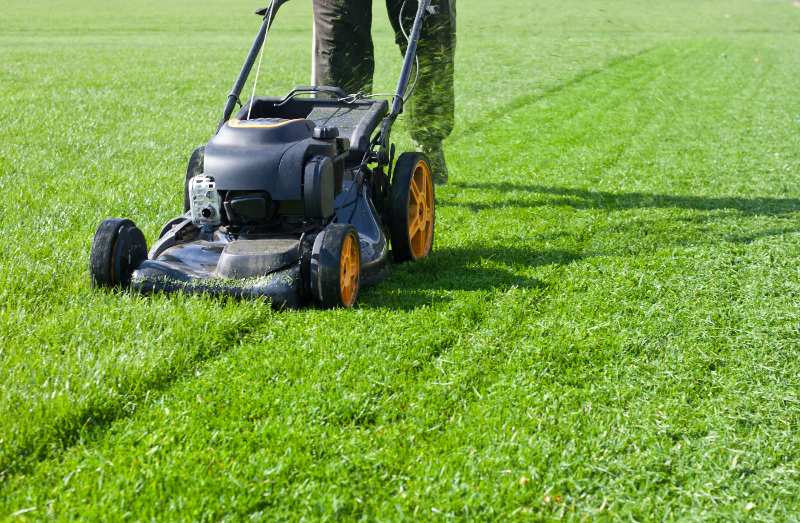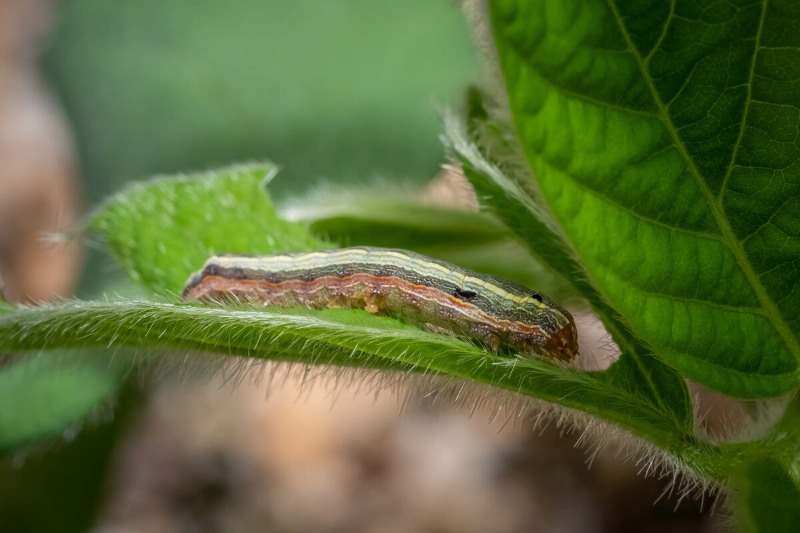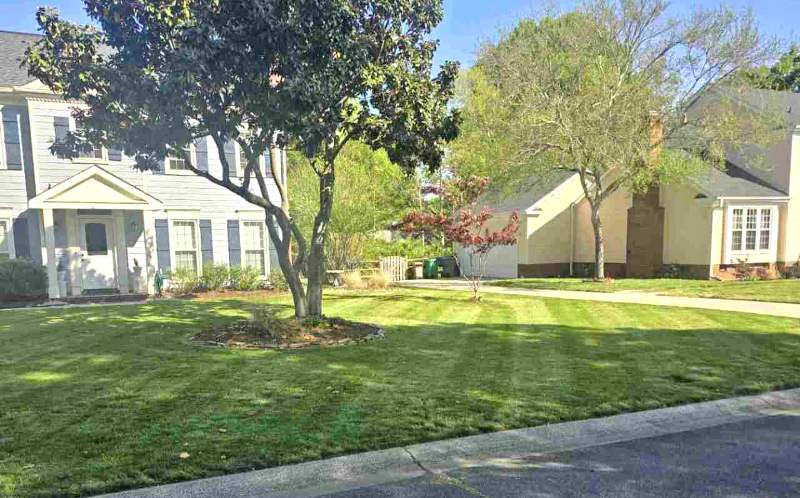
Summer in Charlotte brings heat, humidity, and the occasional thunderstorm – and your lawn feels it all. Warm-season grasses like Bermuda and Zoysia hit their peak growth now, while cool-season Tall Fescue and Kentucky Bluegrass can struggle in the heat.
A smart summer lawn care plan focuses on maintaining turf health through proper watering, mowing adjustments, and pest and disease prevention. Timing and technique matter, especially in our clay-heavy Piedmont soils and humid climate.
Here’s a 7-step summer lawn care plan tailored to Charlotte’s conditions. Use it to keep your yard green, healthy, and ready for whatever summer brings.
1. Water Deeply and Within Local Rules
Watering is your top priority in summer. Charlotte lawns generally need about 1–1.5 inches of water per week, rain included. Deep, infrequent watering helps roots grow deeper, making your grass more drought-tolerant. Be sure to learn and follow Charlotte-Mecklenburg seasonal watering restrictions.
- Tall Fescue / Kentucky Bluegrass: Requires more consistent moisture; don’t let the soil dry completely.
- Bermuda / Zoysia: More drought-tolerant; can handle longer gaps between watering once established.
- Pro tip: Water between 5 a.m. and 9 a.m. to minimize evaporation and disease risk; Late evening is also an option.
See Related: How Often Should I Water My Grass in Summer?
Mecklenburg County Water Use Rules
This table can help you determine when and how to water your lawn while meeting city ordinances. For the most current information, be sure to check the official city website.
| Situation | Charlotte Watering Guidelines |
| Normal/Abnormally Dry | Spray irrigation voluntary odd/even schedule; hand watering anytime |
| Moderate to Extreme Drought | Spray irrigation restricted to 1–2 days/week (late hours); hand watering allowed anytime |
| To Maximize Efficiency | Water before 6 a.m. or after 6 p.m.; zone irrigation; watch for runoff |
2. Adjust Mowing Height for Heat Stress

Raising your mower height slightly in summer can help shade the soil, reduce evaporation, and keep roots cooler.
- Tall Fescue / Kentucky Bluegrass: Maintain 3–4 inches.
- Bermuda / Zoysia: Keep 1.5–2 inches; avoid scalping in dry conditions.
- Pro tip: Mow often enough to remove no more than one-third of the blade length each time.
See Related: When Is the Best Time of Day to Mow Grass?
3. Control Summer Weeds
Crabgrass, dallisgrass, and nutsedge can thrive in the summer heat, and they all spread quickly if not tackled early. Spot-treat problem areas with a post-emergent herbicide labeled for your grass type, and hand-pull weeds when the soil is moist to ensure you remove the full root.
- Tall Fescue / Kentucky Bluegrass: Minimize herbicide use during peak heat; hand-pull when soil is damp for best results.
- Bermuda / Zoysia: Post-emergent herbicides work best before temperatures exceed 85°F to avoid turf injury.
- Pro tip: Don’t mow weeds short to “scalp them out,” as this weakens grass and gives weeds more space to spread.
See Related:
4. Watch for Insect Damage

Charlotte’s hot, humid, and rainy summers invite lawn pests. Grubs, chinch bugs, and armyworms are the most common culprits, and they can quickly turn a healthy green yard into an eyesore.
Irregular brown patches, chewed blades, and spongy turf that lifts easily from the soil are early warning signs of pest activity. If you do notice problems, apply grub control in early to mid-summer, especially if you’ve had infestations in past years. Treat visible pests promptly with a product labeled for your grass type.
- Tall Fescue / Kentucky Bluegrass: Vulnerable to grubs and armyworms. Treat these cool-season grasses promptly with a labeled insecticide if damage appears. Maintain steady moisture to help your lawn recover.
- Bermuda / Zoysia: These warm-season grasses are affected by chinch bugs, dollar spot, and lingering spring dead spot. Preventive grub treatments are useful in early summer if problems have occurred in the past.
- Pro tip: Walk your lawn weekly in summer to spot damage early. Catching pests before they spread makes control efforts more effective.
See Related: 5 Worst Lawn Pests In Charlotte
5. Fertilize Warm-Season Lawns
Summertime is the peak growth season for warm-season grasses, such as Bermuda and Zoysia, in Charlotte. Feeding them now helps maintain a dense, green lawn through the hottest months.
Always follow soil test recommendations for nutrient balance and apply fertilizer evenly.
- Tall Fescue / Kentucky Bluegrass: Skip fertilization in summer; feeding cool-season grasses in high heat can stress them and increase the risk of brown patch. Plan your fertilizer applications for fall and spring instead.
- Bermuda / Zoysia: Fertilize every 4–6 weeks during active growth, beginning once the lawn has fully greened up. Use slow-release nitrogen to promote steady growth without burning the grass.
- Pro tip: Local pros recommend pairing summer fertilization with a light iron supplement for Bermuda and Zoysia lawns to deepen color without adding excess nitrogen that can fuel weeds or disease.
See Related: When (and How) to Fertilize Your North Carolina Lawn
6. Keep Mower Blades Sharp

Sharp mower blades are essential in summer, when lawns are already stressed by heat and humidity. Dull blades tear the grass instead of cutting it cleanly, leaving ragged edges that turn brown and create entry points for disease. Check mower blades every 2-3 weeks.
- Tall Fescue / Kentucky Bluegrass: Bruises easily in summer heat. Sharpen blades at least once a month during peak mowing season to reduce stress and help turf recover faster.
- Bermuda / Zoysia: These warm-season grasses are tougher, but frequent mowing at shorter heights dulls blades quickly. Sharpen every 20–25 hours of mowing for a clean cut.
- Pro tip: Charlotte-area lawn care pros recommend sharpening your mower blades if they show nicks, bends, or resistance during mowing.
See Related:
7. Protect High-Traffic Areas
Between kids, pets, and backyard gatherings, summer puts extra wear on the busiest spots in your lawn. High-traffic zones need proper attention, or they can thin out, compact, and invite weeds.
- Tall Fescue / Kentucky Bluegrass: More sensitive to wear in heat; rotate play areas, move furniture, and avoid repeated traffic on the same paths. Overseed any thin patches in early fall to restore density.
- Bermuda / Zoysia: More durable under foot traffic, but heavy use can still cause compaction. Aerate in late spring or early summer to keep roots healthy and repair bare areas with sod if needed.
- Pro tip: Use stepping stones, mulch paths, and small landscape borders in high-traffic areas to take pressure off the grass while maintaining a functional and attractive yard.
See Related:
- 7 Best Grasses for High-Traffic Yards
- Best Grass for Dogs
- How to Protect Your Lawn During Outdoor Events
Hire a Lawn Care Pro in Charlotte

Summer lawn care takes time, consistency, and the right timing for every task. If you’d rather skip the heat and let a professional keep your grass healthy, LawnStarter makes it easy to connect with local crews.
We work with trusted pros across the Charlotte metro, including:
From mowing and fertilization to pest and weed control, LawnStarter local lawn care pros handle it all—so you can enjoy your yard instead of working in it.
Find Charlotte Lawn Care Pros →
What to read Next:
- Spring Lawn Care Checklist for Charlotte
- 10 Fall Lawn Care Tips for Charlotte, NC
- 4 Best Grass Types for Your Charlotte Lawn
Main Image: Lawn mowed by a LawnStarter pro in Charlotte, NC. Illustration by Whitney Lehnecker / LawnStarter